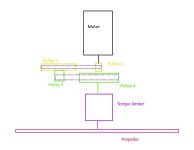larsb
1 MW
at those power levels there's no need for active water cooling. just connect the inrunner stator to the casing with good heat path and use an efficient motor.
larsb said:How will you build the enclosure? This seems like the most difficult part together with sealing cables and shaft.
larsb said:Gears will make it possible to have a smaller motor for the same torque so in the end you won't need to add "an extra kilo" by planetary gears
How much torque is actually needed for the prop?
1000W 1500rpm is about 6Nm if the numbers you have are correct
A c80100 in 50kV will need about 32A to do this, should be possible continuously.
https://alienpowersystem.com/shop/brushless-motors/80mm/c80100-outrunner-brushless-motor-50kv-6000w/
It's a small enough motor, i'd guess?



larsb said:Found this link, nice writeup on a DPV build:
http://pettersen-prod.com/project/dpv/index.html
Maybe it contains something useful.
larsb said:Torque 7.5Nm (normally given torque is max output at full Amps) is probably too low as you might use 6Nm/ 80% of max for longer periods.
It's a bit of a chance, it will probably overheat used at full throttle.
larsb said:BEMF will lower your achievable rpm to about 85% of unloaded / 900rpm as a maximum.
It's better to run 10s and have some headroom left if you want/need to try different props or higher RPM.
The c80100 motor is good, i’ve run one on an ebike for a long time.
Your DPV shell will need to be thermally conductive for any motor and battery to work without overheating. What is your plan for this? An alu tube for the main body would be perfect, don’t know if you can find large enough diameters at a reasonable cost.

larsb said:Input values don't make sense. Is it just for a trial or is it a calculation? What do you want to do?
- The controller can turn high voltage low current input to low voltage high current output - are you aware of this?
- eddy losses go up by the square of the rpm
if you input 55mohm phase resistance and noload current at 1.5A then you'd see that the difference is not large between the driving. You also miss the effect of nonlinear losses like the eddy losses which lowers the high rpm efficiency.
- The torque is not related to the voltage, only to current and efficiency..
